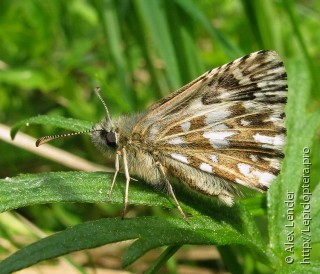Pyrgus malvae
Taxonomy
class Insecta
Species name(s)
Pyrgus malvae (Linnaeus, 1758) = Papilio malvae Linnaeus, 1758 = Papilio fritillarius Poda, 1761 = Papilio fritillum [Schiffermüller], 1775 = Papilio sao Bergstrasser, [1779] = Papilio althaeae Esper, 1783 = Papilio alveolus Hübner, [1800-1803] = Papilio althaeae Esper, 1783 = Syrichthus albina Oberthür, 1910 = Hesperia albina Tutt, 1906 = Papilio alveolus Hübner, 1802 = Syrichtus asiaeclara Verity, 1934 = Hesperia australis Tutt, 1906 = Hesperia bilineata Reverdin, 1914 = Hesperia brunnea Tutt, 1906 = Hesperia cardui Latreille, 1823 = Syrichthus elegantior Verity, 1934 = Syrichthus fasciata Tutt, 1896 = Papilio laveterae Fabricius, 1787 = Hesperia marginoelongata Reverdin, 1914 = Papilio minor Esper, 1777 = Hesperia punctigera Fuchs, 1919 = Hesperia reducta Warren, 1920 = Hesperia restricta Tutt, 1906 = Hesperia rufa Tutt, 1906 = Papilio sao Bergstrasser, 1779 = Papilio taras Bergstrasser, 1783 = Papilio fritillurn Fabricius, 1787 = Hesperia pseudotaras Lacreuze, 1910 = Hesperia mulleri Dioszeghy, 1930 = Pyrgus intermedia Schilde 1886 = Hesperia moryi Strand, 1902 = Hesperia scabellata Reverdin, 1912 = Hesperia zagrabiensis Grunder, 1903. [9, 10, 187]
Grizzled Skipper.
urn:lsid:insecta.pro:taxonomy:8402
Expansion
This species marks on the maps: 7.
Zoogeographical regions
Palaearctic.
Russia regions
#1. Kaliningradsky; #2. Kolsky*; #3. Karelsky*; #4. Evropeisky Severo-Zapadny; #6. Evropeisky Severo-Vostochny; #7. Evropeisky yuzhno-tayozhny; #8. Evropeisky Tsentralny; #9. Evropeisky Tsentralno-Chernozyomny; #10. Sredne-Volzhsky; #11. Volgo-Donsky; #15. Severo-Uralsky; #16. Sredne-Uralsky; #17. Yuzhno-Uralsky; #19. Sredneobsky; #20. Yuzhno-Zapadnosibirsky; #22. Krasnoyarsky; #23. Predaltaisky; #24. Gorno-Altaisky; #25. Tuvinsky; #26. Predbaikalsky; #27. Pribaikalsky; #28. Zabaikalsky; #31. Yuzhno-Yakutsky; #35. Sredne-Okhotsky; #36. Sredne-Amursky; #37. Nizhne-Amursky; #40. Primorsky.
* An asterisk denotes a region for which the species is listed as an migrant or information that requires additional checking.
Forewing length
14—15 mm.
Primary colors
Brown/Gray/Black, White.
Flight time
| January | February | March | April | May | June | July | August | September | October | November | December |
Larva lifespan
| January | February | March | April | May | June | July | August | September | October | November | December |
Over-wintering stage
Pupa.
Detailed information with references
Distribution
Imago Habitus and Differences from alike species
General info about Imago
Imago lifespan
Larva food plants / other food objects
Larva lifespan
Overwintering stage
Subspecies of Pyrgus malvae
- Pyrgus malvae coreanus Warren, 1957. [187]
- P. m. kauffmanni Alberti, 1955. [9]
Authors
Initial species uploading to the site: Peter Khramov.
Text data: Peter Khramov.
The species characteristics formalization: Peter Khramov, Sergei Kotov.
References
- [1] O. Karsholt, J. Razowski (eds.), 1996. The Lepidoptera of Europe: a distributional checklist
- [3] Каталог чешуекрылых (Lepidoptera) России. Под ред. С. Ю. Синёва. СПб.; М.: Товарищество научных изданий КМК, 2008
- [5] Райххолф-Рим Х. Бабочки. М.: Астрель, 2002
- [9] Tree of Life (funet.fi), 2012
- [10] de Jong, Y.S.D.M. (ed.) (2011) Fauna Europaea version 2.4 (faunaeur.org)
- [28] Moths and Butterflies of Europe and North Africa (leps.it), 2012
- [187] Species 2000, http://www.sp2000.org
Comments
Note: you should have a Insecta.pro account to upload new topics and comments. Please, create an account or log in to add comments
Pyrgus malvae photos


















































All the photos of the species in large size
Please, create an account or log in to upload your photo


















